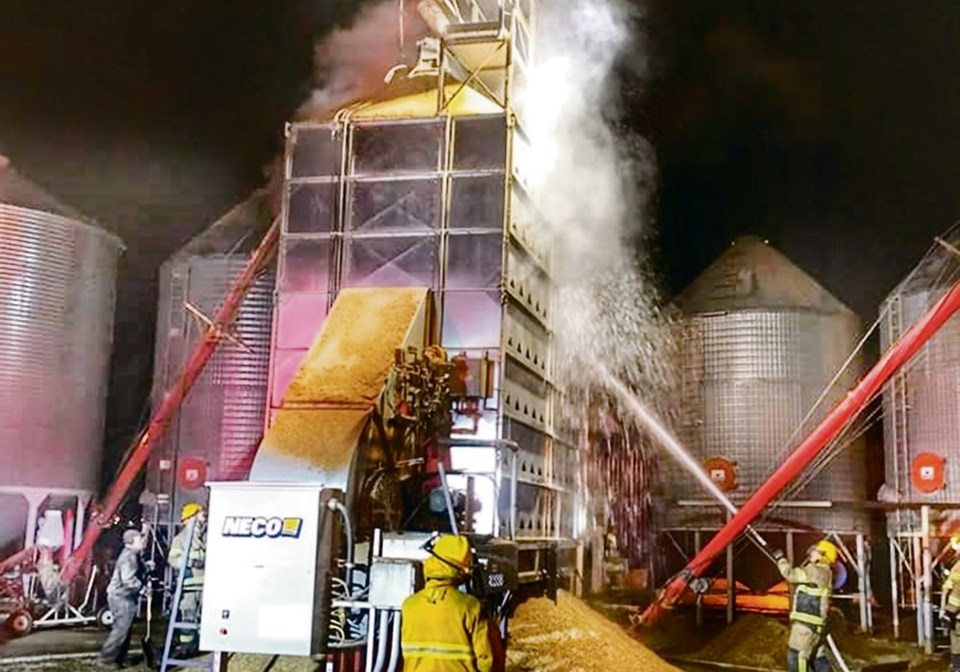WESTERN PRODUCER — It’ll be a busy fall for grain dryers as the short growing season forces a harvest headache, with thousands of B-trains in the lineup with tough grain needing quick attention.
Storing tough grain that hasn’t received proper attention is a good way to waste money, according to GSI dryer specialist Randy Sheley. He says there are two ways your money goes up the chimney.
Fires destroy the crop and the dryer, and backs up your lineup of harvested crop for weeks or even the whole season if a replacement dryer isn’t readily available.
Related story: Water nozzles begin to fight fire inside the dryer
A poorly maintained dryer loses capacity and fuel efficiency. You pay more to dry less.
Sheley says loss of capacity is the first thing that happens when a dryer is ignored. The machine is designed to function with un-hampered air flow. Because a dryer is self-regulating, any air blockage tells the brain to automatically cut back on volume.
“Ignoring it not only cuts capacity, the related symptom is reduction of fuel efficiency. So, you burn more fuel to dry less grain. You definitely don’t want to let trash build up.”
Trash buildup causes about 80 percent of dryer fires, says Sheley, adding that the percent should be closer to zero.
“If fire starts inside the plenum, it usually gets into the grain column itself. Dryer fires can be prevented, but only by keeping the entire mechanism free of trash and debris.
“Some people laugh at me when I give them my recommendation, but I think a dryer should be totally shut down and cleaned out at least once a week. It only takes 15 minutes for the dryer to cool down enough to inspect. You lose less than an hour drying time doing a total cleanout. Now, weigh that against the time you lose if your dryer catches fire.
“Plus, it should be inspected internally every day. It doesn’t matter if the outside is dirty, but it has to be free of all combustibles inside.”
He says farmers should have a fire plan before they start the dryer. Determine how long it takes your fire department to arrive and set up. Then decide if you should invest in a dugout and fire pumps, or other on-farm firefighting apparatus and water storage.
“When they show up at a dryer fire, the first thing firefighters always want to do is start cutting holes in the thing and tearing it all apart. That’s not always necessary. If you have fire in just one column, then go ahead and dump it on the ground and douse it there.
“Dryer fires typically don’t total out the dryer unless it’s a major fire that spreads through the whole structure. So, cutting it up when you only have an isolated fire isn’t required. I estimate that about 80 percent of burned dryers can be repaired.”
Sheley says there are now firefighting systems that locate water sprinklers at key locations within the dryer. When the water arrives, the hose quickly attaches to a standard fire equipment coupling and the fire gets sprayed from within the housing (see sidebar).
He adds that the time is now to have an annual inspection carried out by a qualified technician. Some dealers offer this service for free, while other charge a nominal fee.
Safety — Lock out the electrical main safety disconnect before checking or servicing any electrical or mechanical device on the dryer. Follow the dryer manual for safety guidelines and do not attempt any electrical or gas repairs unless you are qualified.
Cleaning — Make sure all supply augers, downspouts and columns of the dryer are free of any debris or birds’ nests. Thoroughly clean the control box, if not done last fall, and make sure any floors or internal areas are completely free from fines or debris.
Inspection — Check all belts for wear, hardness from age and proper tensioning, and replace any questionable belts. With all valves closed and lines empty for safety, check all gas hoses and connections to ensure all are in good shape and not leaking. Inspect the burner to confirm there are no insect nests or other obstructions that would prevent proper operation
Test run — Check the dryer for proper operation before filling with grain.
Turn on main power to dryer and make sure all emergency stop switches are closed. Be sure all personnel are safely away from any moving parts or electrical connections.
Bring up the control circuit to check safeties and operational screens, then start the load, metering and unload systems while testing automatic safeties and shutdown systems. It is very important to do this before the dryer is loaded with grain to make sure the unload system is operational.
Start fans and burners with the gas supply off to check for proper operation of the safety system. The dryer should shut down within a minute.
After carefully and slowly opening the gas supply, start the fans and then burners to make sure they properly light and operate with no unusual voids or colour in the flame. On some dryer models burners may not be operational until the dryer is filled with grain.
First fill — Make sure the columns fill correctly and the load automatically shuts down after it’s full. Conduct one final inspection after starting the fan, and then the burner, to make sure the gas pressures are correct and the temperature control system is operating properly. Use the manual to start the regular operation of the dryer.
Contact [email protected]

